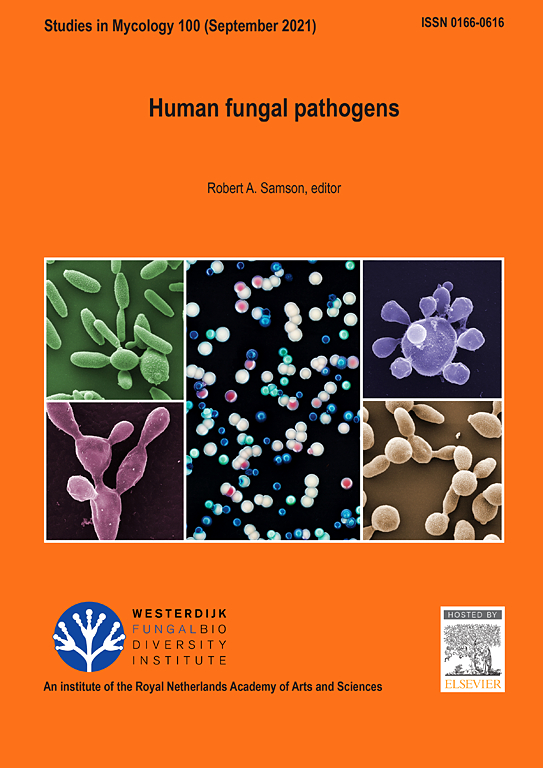寻找消失的麦角虫:日本锁骨种的系统发育再评价及其生物地理格局揭示
IF 17.1
1区 生物学
Q1 MYCOLOGY
引用次数: 0
摘要
尽管麦角主义在更长的时间里就已经为人所知,但它还是在1853年建立起来的。截至2000年,锁骨属已被描述约70个分类群,其中8种和6变种是基于日本模式或真实标本。这些日本锁骨纲分类群大多是基于丢失的标本或无效的名称,这意味着许多物种实际上只存在于科学文献中。这些物种的模糊身份阻碍了锁骨属的分类分辨。因此,我们寻找并收集了300多个新鲜标本,以寻找丢失的日本麦角虫。基于LSU、TEF-1α、TUB2、Mcm7和RPB2 DNA序列的多位点系统发育分析揭示了日本标本与已知锁骨头属(Claviceps spp.)的系统发育关系,以及存在的生物地理格局。基于系统发育分析、寄主范围和形态特征,对日本锁骨虫进行了重新鉴定,鉴定出日本锁骨虫至少21种。在这里,我们对14个先前描述的分类群进行了表征,并为C. bothriochloae、C. imperatae、C. litoralis、C. microspora、C. panicoidearum和C. yanagawaensis指定了neo-型、lecto-型和epi-型。两个品种被提升到具有指定新型的种级,即C. agropyri和C. kawatanii。提出并描述了C. miscanthicola、C. oplismeni、C. palustris、C. phragmitis、C. sasae和C. tandae 6个新种。本文章由计算机程序翻译,如有差异,请以英文原文为准。
In search of lost ergots: phylogenetic re-evaluation of Claviceps species in Japan and their biogeographic patterns revealed
Claviceps (Clavicipitaceae, Hypocreales) was erected in 1853, although ergotism had been well-known for a much longer time. By 2000, about 70 taxa had been described in Claviceps, of which eight species and six varieties were based on Japanese type or authentic specimens. Most of these Japanese Claviceps taxa are based on lost specimens or have invalid names, which means many species practically exist only in the scientific literature. The ambiguous identities of these species have hindered taxonomic resolution of the genus Claviceps. Consequently, we sought and collected more than 300 fresh specimens in search of the lost Japanese ergots. Multilocus phylogenetic analyses based on DNA sequences from LSU, TEF-1α, TUB2, Mcm7, and RPB2 revealed the phylogenetic relationships between the Japanese specimens and known Claviceps spp., as well as the presence of biogeographic patterns. Based on the phylogenetic analysis, host range and morphology, we re-evaluated Japanese Claviceps and recognised at least 21 species in Japan. Here we characterised 14 previously described taxa and designated neo-, lecto- and epi-types for C. bothriochloae, C. imperatae, C. litoralis, C. microspora, C. panicoidearum and C. yanagawaensis. Two varieties were elevated to species rank with designated neotypes, i.e. C. agropyri and C. kawatanii. Six new species, C. miscanthicola, C. oplismeni, C. palustris, C. phragmitis, C. sasae and C. tandae were proposed and described.
求助全文
通过发布文献求助,成功后即可免费获取论文全文。
去求助
来源期刊

Studies in Mycology
生物-真菌学
CiteScore
35.60
自引率
3.00%
发文量
7
期刊介绍:
The international journal Studies in Mycology focuses on advancing the understanding of filamentous fungi, yeasts, and various aspects of mycology. It publishes comprehensive systematic monographs as well as topical issues covering a wide range of subjects including biotechnology, ecology, molecular biology, pathology, and systematics. This Open-Access journal offers unrestricted access to its content.
Each issue of Studies in Mycology consists of around 5 to 6 papers, either in the form of monographs or special focused topics. Unlike traditional length restrictions, the journal encourages submissions of manuscripts with a minimum of 50 A4 pages in print. This ensures a thorough exploration and presentation of the research findings, maximizing the depth of the published work.
 求助内容:
求助内容: 应助结果提醒方式:
应助结果提醒方式:


